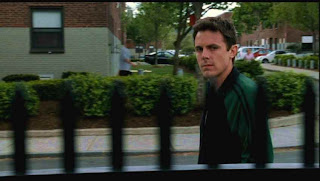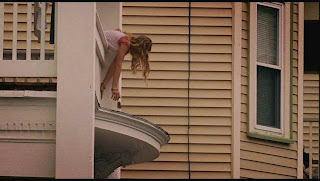or
A Dangerous Breed
I really like Dennis Lehane's writing. I've never read any of his books and I am, in fact, rather leery of starting one (as I am with starting anything by Cormac McCarthy). But the films based on his stuff have been pretty cracker-jack, even if the kernel of his ideas are there when the films have proved less than five-star.
A lot of modern writing is based on a cynical world-view that things are bad and that it is a "given." This is considered hip and "worldly" (to anything other than "Disney"), but I find it safe, unimaginative and, frankly, boring (typical of this is Frank Miller's pulp-style usurpation "Sin City"). I find myself saying "Yeah, yeah, life stinks, so give me an alternative or a solution—just don't ladle on the cynicism and then cop-out with a light at the end of the darkened tunnel. Do something with it." What I like about Lehane is he drops you into that same cynical world-view, does not compromise with it or become "clever," and then yanks the rug out from under you to show you that it's even worse than you thought.
There's a style of film called film noir that appeared after World War II, born of the pulps and the devastation that the cruelty of life (and death), as exemplified by that most horrible of wars, inflicts on the human psyche, good and bad. Film Noir was more than just hard-boiled detective movies in stylized black-and-white (I'm talking to you, Frank Miller). The best description I've read of "noir" is "when the streets are dark with something more than night"—there's a permeating sense of evil, but something worse than evil—of indifference. Film noir exists in a world without God, or even of a presence that offers comfort or protection. In that sensibility, Life's a crap-shoot. And the dice may be loaded. And may have always been loaded.
The latest film based on Lehane's writing, The Drop, is the author's own expansion of his 2009 short story "Animal Rescue." So much of it takes place during the day you could call it "Noir with the lights on." But, despite the sun shining through an overcast sky, it's noir, sure as shooting.
Bob Saginowski (Tom Hardy, amazing in this, but you have to see it to understand why) seems simple. He's generally expressionless, speaks in a flat monotone and when he speaks it's slow, measured and doesn't veer too far from the obvious. For fourteen years he's been steady in a job bartending at his cousin Marv's saloon (Marv is played by James Gandolfini, his last role). Marv's had a bit of bad luck, and he's had to sell the bar to Chechen gangsters (Marv calls them Chechnyans; Bob corrects him) who use the bar as a money-drop for loan sharks and book-makers. Bob's life is solitary, except for his rituals—work at the bar in the evening, morning mass at 8 am.
It isn't a drama if something doesn't disrupt that: first, on his way home from work, Bob hears a whining from a garbage can. Looking in, he finds a battered pit-bull puppy tossed hap-hazardly. Bob takes the puppy from its garbage-kennel and is confronted by Nadia (Noomi Rapace) who's wondering why he's rooting around in her garbage. The puppy is explained, and soon the two are cleanly the dog up and Bob considers what he's going to do with a dog.
"That's a lot of responsibility," he says.
Nadia takes the dog for a couple days, and when Bob takes the dog, she helps him shop for the animal, now dubbed "Rocco" (after the saint, patron of dogs and the falsely accused) so that he can better handle the responsibility.
Then, Marv's bar (actually the Chechen's) is robbed by a couple of masked punks at gun-point. The police come and investigate and Bob tells one of the detectives (John Ortiz), whom he recognizes from church, that one of the bandits had a broken wristwatch. Marv is peeved by this. But, it doesn't matter. Pretty soon, a plastic bag is found hanging from the bar's fence containing the stolen money, as well as a severed arm with a broken wristwatch.
Then, Eric Deeds (Matthias Schoenaerts) starts nosing around. Bob first encounters him when walking Rocco one day. Deeds passes him and mentions that he's got a nice dog. Then, he shows up at Bob's house and informs him that Rocco is his dog and he'd better give him back. Deeds has a reputation—number one, he's crazy and number two, it's bandied about the neighborhood that Deeds might have been responsible for the disappearance of one Richie Sanders ten years ago, never to be seen again. Deeds is someone no one wants to mess with, especially, when Bob learns that he is Nadia's ex-boyfriend.
 |
| Body language adds to the conversation in The Drop. |
How this all plays out depends on you, the movie-goer, not knowing what you don't know, the gambit behind any mystery story. You're dropped into the story without any past knowledge, no history, and how it plays out is totally dependent on that. In that way, it's a bit more like Mystic River and Shutter Island, with twists, rather than the moral quandries that Lehane proposed in his early writings.
The direction is fairly straightforward, but the performances are quite amazing. Hardy is one of the best British actors out there, but he tamps down his potential theatricality that he's displayed in other roles to make his Saginowski an extraordinarily internal performance. Rapace, who's always had a nervous energy to her, infuses Nadia with a sense of hidden secrets, and Gandolfini is all bitterness and impatience as a frustrated former enterpreneur who can't seem to let go of the past. Schoenaerts matches Hardy in their scenes together with an indifferent menace that knows no boundaries.
 |
| "...when the streets are dark with something more than night." |
The Drop shrugs along, adding little clues, telegraphing elements that resonate and ultimately come together to a logical conclusion. It is only at the very end that it tends to fail, adding a hopeful coda that doesn't seem to fit in with the rest of the atmosphere of the film. Still in the dog-days of the autumn movie season before the onslaught of Christmas releases, The Drop is a bit of fresh air, provin there's still some life in the old black dog yet.


































































